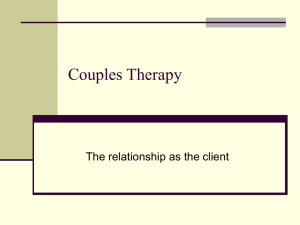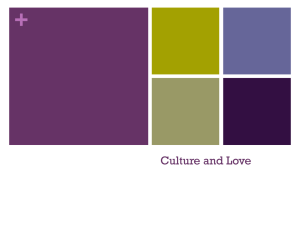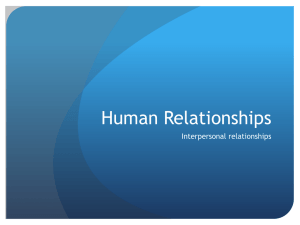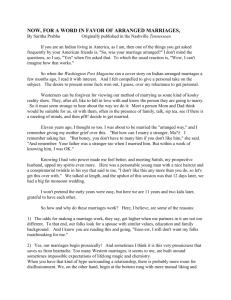Interpersonal relationships review
advertisement
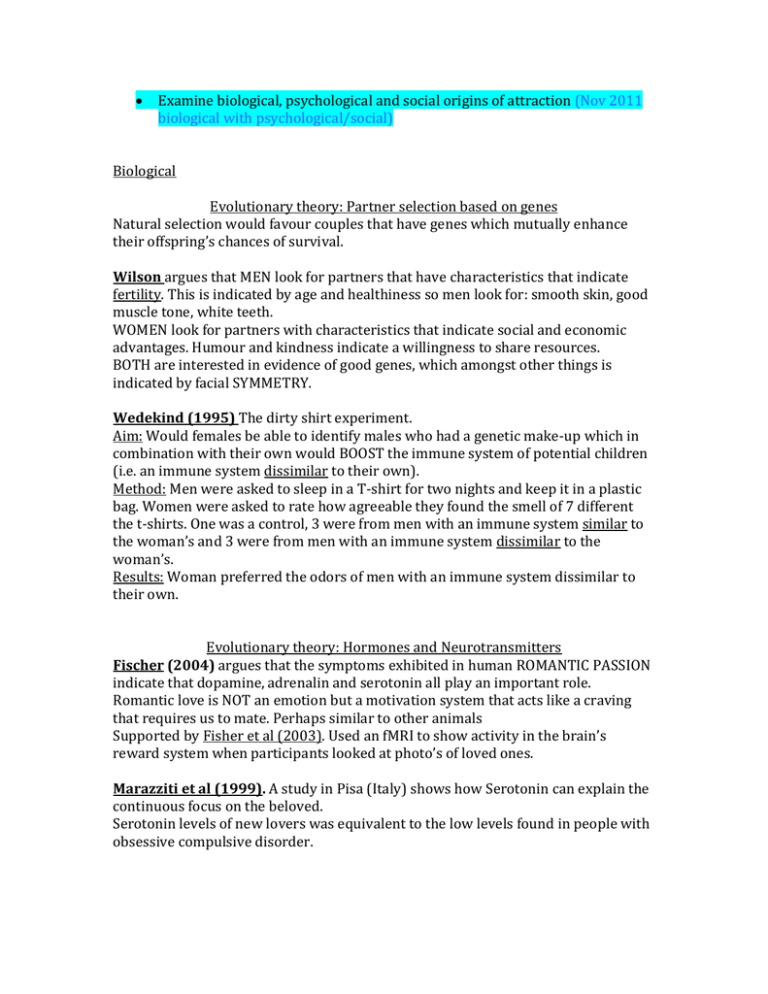
Examine biological, psychological and social origins of attraction (Nov 2011 biological with psychological/social) Biological Evolutionary theory: Partner selection based on genes Natural selection would favour couples that have genes which mutually enhance their offspring’s chances of survival. Wilson argues that MEN look for partners that have characteristics that indicate fertility. This is indicated by age and healthiness so men look for: smooth skin, good muscle tone, white teeth. WOMEN look for partners with characteristics that indicate social and economic advantages. Humour and kindness indicate a willingness to share resources. BOTH are interested in evidence of good genes, which amongst other things is indicated by facial SYMMETRY. Wedekind (1995) The dirty shirt experiment. Aim: Would females be able to identify males who had a genetic make-up which in combination with their own would BOOST the immune system of potential children (i.e. an immune system dissimilar to their own). Method: Men were asked to sleep in a T-shirt for two nights and keep it in a plastic bag. Women were asked to rate how agreeable they found the smell of 7 different the t-shirts. One was a control, 3 were from men with an immune system similar to the woman’s and 3 were from men with an immune system dissimilar to the woman’s. Results: Woman preferred the odors of men with an immune system dissimilar to their own. Evolutionary theory: Hormones and Neurotransmitters Fischer (2004) argues that the symptoms exhibited in human ROMANTIC PASSION indicate that dopamine, adrenalin and serotonin all play an important role. Romantic love is NOT an emotion but a motivation system that acts like a craving that requires us to mate. Perhaps similar to other animals Supported by Fisher et al (2003). Used an fMRI to show activity in the brain’s reward system when participants looked at photo’s of loved ones. Marazziti et al (1999). A study in Pisa (Italy) shows how Serotonin can explain the continuous focus on the beloved. Serotonin levels of new lovers was equivalent to the low levels found in people with obsessive compulsive disorder. The role of hormones in bonding Two hormones help to increase the bond between lovers. Oxytocin Experiments conducted on laboratory rats have shown that when oxytocin is inhibited, new mothers reject their young. Yet when oxytocin was injected into female rats that had never mated, it caused them to demonstrate nurturing behavior towards other rats’ young. Most researchers found that oxytocin tends to deepen and intensify feelings of attachment. This is released in both men and women during touching and sex. Thus couples feel closer and more bonded. Oxytocin is also released during childbirth and is believed that it helps to secure the bond between mother and infant. Vasopressin Winslow et al. (1993) Can use in BLOA. Or can use Buss and jealously during the menstrual cycle. Vasopressin is associated with long tern commitment. It is also released during sex. An experiment on the role of vasopressin was conducted using prairie voles. These animals tend to form stable pair bonds and have more sex than is necessary for reproduction, just as humans do. When male prairie voles were given a drug that suppressed the effects of vasopressin, they lost their devotion to their mates and no longer protected them from potential suitors. This provides evidence that vasopressin plays an important role in males’ attachment and mating behavior Evaluation + Research indicates that there are universal biological systems involved in attraction and love. - Data from brain imaging can indicate activity in an area, but the brain is complex and it is not yet possible to explain human attraction. - Evolutionary theories cannot explain attraction and love between same sex partners as they do not produce offspring. - Cultural factors in attraction are ignored. Psychological/Cognitive Similarity Morry (2007) Attraction-Similarity model (Opposites don’t attract!) Couples tend to be similar in age, religion, social class, cultural background, personality, education, intelligence, physical attractiveness and attitudes. She states that attraction predicts perceptions of similarity. This has a psychological benefit according to Byrne as it validates one’s opinions and self esteem. Evidence Markey & Markey (2007) Demonstrated how single people looking for romance tended to describe their ideal partners as similar. Method: Around 200 single participants were recruited using a self selected sample through advertisements. They were interested in finding a romantic partner. They completed a questionnaire, which rated their own personality and then described the personality of their romantic ideal. There were also filler questions. Results showed that all participants wanted a romantic partner similar to themselves. Warm - warm, dominate – dominate. Evaluation: +Large sample increases the validity - Participants were young Americans so not possible to generalize findings - Self report questionnaires can lack reliability - However, a follow up study with couples however showed those in relationships that consisted of opposites of the specific trait submissive/dominant were the most harmonious. This indicates that certain “different” traits complement each other. Self Esteem Kiesler and Baral (1970). The role of self esteem in relationship formation. They were give an IQ test. One group were told that their scores were “off the charts” high and another group were told that their scores were extremely low. Scores were given individually and afterwards when they were waiting for their pay in a waiting room an attractive female entered. They found that men who had a self-esteem boost (high IQ scores), engaged in conversation with a very attractive woman more quickly and were more engaged than men who were given low scores. Social Proximity and familiarity Festinger et al (1950): Proximity. The smaller the distance between individuals the greater the chance of attraction taking place. Investigated the formation of friendship formation in Westgate housing (dorm for student couples). A field study using observations and interviews. Found that the more exposure and proximity there was, the more likely that residents would become friends. 10 times as many friendships developed with people who lived in the same building, and even more with people who lived next door. Conclusion: Familiarity; as a result of proximity is the cause of attraction Links back with Morry’s theory as greater familiarity will lead to greater awareness of potential similarities. Zajonc et al (1971): Exposure. Photo’s of strangers who appeared more often were rated more positively. We like the familiar. Evaluation + Interaction provides us with a sense of connectedness and attachment-a basic human need. + Proximity and familiarity are becoming more relevant and easily achieved with the introduction of the internet and social media. We can gain “psychological proximity” without “geographical proximity”. - Doesn't explain on its own why attraction occurs but rather indicates factors which increase the likely hood of them. The role of culture This overlaps with another learning outcome (Explain the role that culture plays in the formation and maintenance of relationships) Buss (1994). Large cross cultural study. International Mate selection Project with over 10,000 participants. Found that some characteristics such as a prerequisite for love in a relationship were universal across cultures. Also in 36 out of 37 cultures women ranked financial prospects as more important than males. In all 37, men preferred younger mates and women preferred older mates. Physical attractiveness was also valued more by men than by women but there was cross-cultural agreement in attractiveness (clear skin and full lips). The degree of agreement in sex differences across cultures led Buss to view mate selection preferences as universal. This links with the evolutionary approach and supports it. However there were some differences. Chastity was valued differently amongst cultures. Highly valued in China, India and Taiwan but NOT in Scandinavia and the Netherlands. Also highlighted differences between what men and women found attractive Evaluation + Wide sampling - Samples within each country were not representative - There were problems with translating the questionnaire and responses accurately - Doesn't account for personal variations in what is found to be attractive Conclusion Attraction and its origins is complex and based on an interaction of biological, cognitive and social factors. With so many divorces occurring today, perhaps the maintenance of a relationship is just as important as the attraction that causes it. Discuss the role of communication in maintaining relationships Role of attributions (links to cognitive in general learning outcome) Dispositional Attributions: personal attributions, behaviours as a result of themselves Situational Attributions: environmental attributions, behaviours are a result of factors external to themselves In happy relationships positive behaviours are seen as dispositional “he gave me flowers because he is kind” and negative behaviours are seen as situational “he forgot my birthday because he has been so busy at work”. In unhappy relationships it is the opposite. Negative behaviours are seen as dispositional “ he forgot my birthday because he is selfish” and positive behaviours are seen as situational “he gave me flowers because they were half price”. People in these relationships also employ stable, “You always…” and global, “You never…” attributions. Evidence: Fletcher et al (1987) Aim: Investigate if patterns of attribution effected relationship satisfaction (happiness, commitment, love) Method: 100 female and 31 male US students who were in relationships but not living together were used as participants. Participants initially completed a number of questionnaires. 2 months later, 95% of participants were still in their relationships. These participants asked to write a free-response description of their relationship and fill out another questionnaire. Results: Those with the highest relationship satisfaction after 2 months, attributed positive behaviour as being dispositional and negative behaviour as being situational. Those in happy relationships tended to use more interpersonal terms (we) in the free response. Participants who made situational attributions for relationship maintenance reported significantly less happiness, commitment and love Evaluation: • - Sampling bias, a lot more females than males • - Culture bias, US only thus hard to generalise results • - Data was self-reported; possibly not accurate • - Participants were all students, hard to generalise results Evidence also supported by Bradbury and Fincham (1990) Conducted a meta-analysis of research on attributions in married couples. Spouses in happy relationships: 1. Linked positive events to dispositional factors in the partner (because of partner) 2. Linked negative events to situational factors (partner not to blame) While spouses in unhappy relationships tended to make the opposite attributions 1. Linked positive events to situational factors in the partner (do not happen because of partner) 2. Linked negative events to dispositional factors (partner is to blame) Duck (1988) Conflict is an inevitable part of a relationship. The handling of conflicts can either promote the growth of a relationship or end it. Thus the important part of a relationship is not the presence of conflict but rather how it is solved. Role of Communication of emotions Emotional expression and control seem to play a role in conflict resolution and marital satisfaction. Non-verbal factors can predict emotional expressions according to Gottman and Levenson (1986) Gottman (1979) – Dissatisfied couples displayed more negative affects were more likely to return negative affects. Known as negative reciprocity or retaliation, it is easy to predict how these couples would interact in conflict situations based on the spouse’s behaviour. Evidence: Levenson and Gottman (1983) Method: Observational study. 30 couples were observed in a laboratory setting. They were given a low-conflict discussion on an event of the day (such as “no one did the washing up”) and a high-conflict discussion on a major source of disagreement in their relationship (such as “you have never liked my Mother and are always rude”). These discussions were videotaped and spouses afterwards returned to make individual self-evaluations regarding their communication. Results: Marital dissatisfaction was associated with higher levels of expressed negative emotions (negative affect) and return of negative affect (retaliation). Physiological measures were also conducted during the sessions such as heart rate, skin conductor. Unhappy couples displayed similar physiological arousals (stress response). Concluded that unhappy couples experience a negative spiral that leads to stress and mutual unhappiness. Evidence of other dysfunctional communication: Gottman and Krokoff (1989) Method: Compared data from two longitudinal observational studies of couples. Couples were observed both at home and in a laboratory discussing either a low or high conflict issue. Conflict was only seen as a negative sign if couples could not resolve it constructively. Results: showed that expression of anger and disagreement did not necessarily lead to marital dissatisfaction. Rather couples who solved the conflict with mutual satisfaction were happier with their relationship. While couples who avoided conflict were less happy. Researchers believe that this was because they did not have the opportunity to solve the conflict together. Dysfunctional communication patterns (defensiveness, stubbornness and withdrawal from interactions) reliably lead to marital dissatisfaction over time. Gottman put together a theory regarding the importance of communication in relationships: Theory of the Four Horsemen of Apocalypse, factors that predict marital dissatisfaction. Criticism: making dispositional attributions e.g. ad hominem attacks on the partner Contempt: attacking the partner’s sense of self with intention to insult or abuse e.g. sarcasm or mockery. Defensiveness: seeing yourself as the victim e.g. listening to a partner’s compliant but returning it with your own. Stonewalling: Withdrawing from the relationship as a way to avoid e.g. silent treatment, changing subject. The role of positive communication Gottman et al found that expressions of positive affect (particularly non-verbalsmiles and touching) are generally associated with increased intimacy and relationship satisfaction. Noller and Gallois (1986) Spouses who used more positive non-verbal communication also reported a higher level of marital satisfaction. Importance of understanding communication in relationships Partners with communication problems can learn new positive communication patterns. They can use more positive affects and use less negative affects. Being aware of and avoiding the Four Horsemen of the Apocalypse and trying to understand your partner’s expressed emotions are important. Social Penetration theory: Altman and Taylor argue that close relationships are formed by a gradual process of self disclosure (superficial to intimate). Self disclosure is the sharing of facts about one’s life with a loved one, as well as inner thoughts and emotions. It leads to the feeling of being truly known and accepted by the listener. It leads to mutual understanding and also allows each partner to meet the needs of the other. Collins and Miller Carried out a meta-analysis of self disclosure studies and found that people who disclose intimate information about themselves are more liked than people who don’t. People also tend to disclose more personal information to those they like. There are gender differences in disclosure. Women self disclose more than men. Also women self disclose more to other women than men do to other men (Reiss 1986). These different styles may lead to conflict. Explain the role that culture plays in the formation and maintenance of relationships Introduction (definitions): Why study cross cultural differences in relationships? Culture can be defined as the norms and values that define a society. Culture therefore plays a role in the formation and maintenance of relationships. Differences in western and non-western Moghaddam et al (1993) point out many differences between western and nonwestern cultures that can profoundly affect the nature of relationships. Individualistic-emphasising the individual, their goals, rights, attitudes and needs. Collectivist-emphasising the group, its decisions, attitudes, needs, and one’s duties towards it. In western cultures: Interpersonal relationships tend to be individualistic, voluntary and temporary. In non-western cultures: Interpersonal relationships tend to be collectivist, involuntary and permanent. Differences in collectivist and individualistic countries in formation of relationships Bellur (1995): in collectivist cultures: social networks motivate marriages. Families play an active role in choosing marriage partners for young. Love is supposed to be discovered after marriage. This leads to arranged marriages which are the most common forms of marriage arrangement in collectivist cultures. Singh (2005): Arranged marriage in India. The majority of marriages in India are still arranged by the parents or their representatives, with or without the consent of the boy or girl involved. There is no room for romantic marriage in the western sense. Evidence of cultural differences: Levine et al asked college students from 11 countries - If they would marry someone who had all qualities they desired even if they didn’t love the person - USA: 4%, Australia: 5%, UK: 8%. These are individualistic countries. - India: 49%, Pakistan: 51%; collectivist countries. Duck (1999): individualistic cultures assume: free choice of a spouse – based on love, but may be arranged in reality, by social position, religion, wealth, class. Major supporting study that gives more specific details on similarities and differences. Buss (1994). Large cross cultural study. International Mate selection Project with over 10,000 participants. Found that some characteristics such as a prerequisite for love in a relationship were universal across cultures. Also in 36 out of 37 cultures women ranked financial prospects as more important than males. In all 37, men preferred younger mates and women preferred older mates. Physical attractiveness was also valued more by men than by women but there was cross-cultural agreement in attractiveness (clear skin and full lips). The degree of agreement in sex differences across cultures led Buss to view mate selection preferences as universal. This links with the evolutionary approach and supports it. However there were some differences. Chastity was valued differently amongst cultures. Highly valued in China, India and Taiwan but NOT in Scandinavia and the Netherlands. Also highlighted differences between what men and women found attractive Evaluation + Wide sampling - Samples within each country were not representative - There were problems with translating the questionnaire and responses accurately - Doesn't account for personal variations in what is found to be attractive Maintenance of relationships A large proportion of marriages in Western cultures end in divorce. In some countries it is up to 50%. In some cultures, divorce is non-existent or rare (China). This would suggest that people who have an arranged marriage have a better chance of maintaining it. Evidence: Fiske (2004): Found that arranged marriages usually last longer than romantic marriages. Powerful bonds are created as the marriage is a contract between families and may involve economic arrangements. Divorce is not an option and this could account for the stability. Are arranged marriages happier? Evidence for: Gupta & Singh (1982) Interviewed 50 Indian couples. Newlyweds who married out of love reported more intense feelings of love than those from arranged marriages. After 5 years of marriage the findings were reversed indicating that people in an arranged marriage are happier after time. Yelsma and Athappilly (1988): compared 28 Indian couples in arranged marriages, 25 Indian couples in love marriages and 31 American couples in love marriages. Individuals in arranged marriages scored higher on marital satisfaction. Are arranged marriages happier? Evidence against: Xiaohe and Whyte (1990): Investigated the prediction of defenders of arranged marriages that “love matches start hot grow cold, while arranged marriages start cold grow hot”. Method: Investigated 586 married women in the Sichuan province in China. The role of parents had declined and young people were more involved in matchmaking The researchers found that the wives in love marriages were more satisfied with the marital relationship than the wives who were in arranged marriages, regardless of marriage length. Conclusion: This data doesn’t support idea that arranged marriages are happier. Overall Conclusion Hogg & Vaughn (1998): In spite of the focus on love in relationships in West, there’s general agreement amongst psychologists that: A relationship that survives over time is when partners change with respect to what they expect of each other. You could argue that the low success rate in the maintenance of Western marriages is the expectation that your partner will stay the same as when you first met them. This is not realistic. Love that involves friendship, caring, respect, and mutual sharing could result in the powerful bonding of lasting relationships. You could argue that this is allowed to develop in an arranged marriage, rather than the focus on romantic passion in Western marriages. Analyse why relationships may change or end (2012) Note: You may include studies and theories from the previous learning outcome “Discuss the role of communication in maintaining relationships”. Social exchange theory Kelly and Thibaut (1959) argue that relationships are maintained through a cost-benefit analysis In other words the costs must not outweigh the benefits. Although the relationship may be non equivalent for short periods, it must be profitable for both partners in equal measure if the relationship is to survive. Equity theory: Elaine Walster Equity theory of love predicts that there must be a balance between two partners in a relationship, it must be perceived as fair. Hatfield (1979)-found that those who felt deprived or under benefitted had extra martial sex sooner after marriage and with more partners than those who felt either fairly treated or over benefited. Those with equitable relationships predicted they would still be together after 1 and 5 years. Those who felt deprived OR over benefited did not predict their relationship would last. Relationship breakdown occurs if one or both partners are dissatisfied with their comparison levels of reward. Evaluation: The theory is rather cold and mercenary and does not deal with emotions. Reductionist. Cannot be applied to all cultures as it is derived from the values of capitalistic societies. It is difficult to quantify all psychological costs and rewards in a relationship to test the theory. (However-partners do tend to be equally physically attractive). Self reports do not always get reliable information. Rusbult et al Patterns of accomodation The theory highlights the importance of how an individual responds to a partner’s negative behaviour. Constructive accommodations: discussing problems, forgiving, waiting for improvements. Destructive accommodations: silent treatment, bringing up past failures, physical avoidance. Murray and Holmes Idealization of one’s partner seems to lead to constructive accommodations. They found that over time partners in committed relationships create “positive illusions” of their partners. The idealization of the partner was associated with satisfaction and less conflict. If a person is not willing to adopt a constructivist approach to negative behaviour, the relationship ends. Evaluation: Tries to address the role of emotions in a relationship-may idealize partner more at the beginning of a relationship or may be committed to making a relationship work. Idealization could also be a threat to a relationship if the partner does not live up to the high expectations. Flora and Segrin Aim: To investigate the extent to which shared interests and spending time together was a predictor of perception of quality of the relationship. Procedure: The participants were 66 young dating couples (of 6 months) and 65 married couples (of 4 years). The study was a longitudinal study. Data collection took place through self report questionnaires and interviews. At the beginning of the study participants described positive and negative feelings, disappointment and contentment with their partner. After 12 months the participants filled out questionnaires to measure well being and satisfaction with the relationship. All married couples were together but 25% of the dating couples had split up. The researchers were interested in finding possible factors that could predict either break-up or satisfaction. Results: Satisfaction with a relationship for men depended on common interests and spending time together. For women, the best predictor of staying in a relationship and satisfaction was the amount of their own negative feelings about their partner. Evaluation: The study was conducted with a sample from the USA so it may not be possible to generalize findings. Self reports can be bias. Can you predict the breakdown of a relationship? Duck (1992) carried out a meta-analysis of longitudinal studies and found the following factors could predict the end of a marriage. People who had parents that had divorced. Teenage marriages. Marriage between partners of different backgrounds (socioeconomic, cultural, education). Marriage between people from a lower socioeconomic background. Marriage between partners who have had many sexual partners before the marriage. Conclusion Relationships offer comfortable predictability. Relationships end when this predictability is disrupted. Do people simply fall out of love? Sprecher (1999) Carried out a longitudinal study to find out. Couples self reported their feelings about the relationship over several years. In the relationships that eventually broke up, individuals reported higher levels of general dissatisfaction and frustration with the relationship. BUT there was no change in their feelings of love for one another. When frustrations outweigh positive feeling of love, couples break up. The feelings of love that still exist make breaking up painful.
